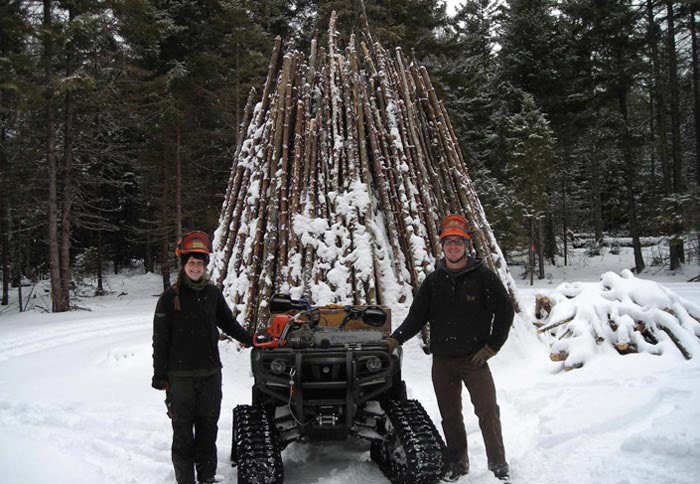The roar of a chainsaw breaks the stillness of the cold winter morning. I wade through knee-deep snow to retrieve a newly fallen balsam fir. With sappy gloves, I drag the fir pole to a fresh bundle of trees that will be hauled by ATV to the nearest landing; with triangular snow tracks instead of wheels, the machine looks like something out of Star Wars. The crackling of a tree resonates to the right. Another tree down – a beech this time, small but already showing symptoms of beech bark disease. This is a typical morning as Assistant Forest Manager at North Country School.
Located outside of Lake Placid in New York’s Adirondack Mountains, North Country School is a small, independent school for children in grades four through nine that has been offering a diverse, outdoor-based education since 1938. Here, students learn skills ranging from raising and harvesting poultry to designing and building theatre sets. Since last October, I have been working with Forest Manager Tucker Culpepper on 200 acres owned by the school and 150 acres of adjacent private land. The forests that we manage include a sugarbush, white, red, and Scotch pine plantations, and spruce-fir lowlands.
Much of our management consists of removing low quality trees so that the better-quality trees can flourish. Tucker explains the process as “leaving the best and taking the rest.” The trees that remain will provide wildlife habitat and natural beauty; some will someday be harvested to provide lumber for the school.
The wood we harvest is used in our school’s 1.4 million btu/hour woodchip boiler, which provides heat for the 32,000-square-foot main school building, and two 500,000-btu/hour cordwood boilers. To feed the woodchip boiler, we cut trees that are 3 to 6 inches in diameter and up to 12 feet long. After the trees are felled, we remove the limbs, leaving the crown and branches on the forest floor. This allows nutrients to be recycled back into the soil. We haul the poles to landings, stack them vertically, and let them dry for approximately seven months. When the poles reach the 30 percent moisture mark, they’re run through a six-inch chipper. Over the past two years, burning wood has allowed us to reduce our fuel oil consumption by more than 80 percent, from an average of 27,000 gallons to about 5,000 gallons a year.
Because the school is on the property, we are able to incorporate education into our forestry practices. Students learn about sustainable forestry firsthand and play a role in choosing and cutting fuel wood. Each weekday after classes, students of any age have the opportunity to sign up to fell trees and stack wood. The forests surrounding North Country school also provide a living classroom for lessons in botany, ecology, and dendrology.
“Last load!” Tucker yells from across the woods. As the sun lowers to retire for the day, we drop off the bundle of trees, stack the logs, and head to the maintenance shop to clean our saws. We brush away the grime and sawdust of our day’s work, sharpen the chains, and leave our gloves on the stove to dry in preparation for another cold winter morning working in the Adirondack forest.



Discussion *